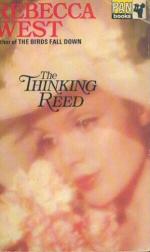|
This section contains 141 words (approx. 1 page at 300 words per page) |

|
Many novels contemporary to West's elaborate the social and cultural malaise of the 1920s caused by the First World War. In America, F. Scott Fitzgerald's The Great Gatsby (1925) illustrates the shallowness of the rich in the Jazz Age. In England, Ford Madox Ford, D. H. Lawrence, and Virginia Woolf, in various modes, critiqued a valueless modern society. Behind all these writers lies T. S. Eliot's central critique of postwar modern society, the poem The Waste Land (1922). Many waste land motifs run through West's novel. And West's harsh condemnations of modern economics has precedent in the novels of Charles Dickens, such as Bleak House (1852-1853). Although these precedents provide a context for understanding West's novel, The Thinking Reed remains one of West's most original and innovative novels. And therein rests it popularity and value for the contemporary reader.
|
This section contains 141 words (approx. 1 page at 300 words per page) |

|




